Rotation
(1) Introduction
- In this chapter, we will study about the special kind of motion of a system of particles that is rotation
- We see examples of rotational motion in our everyday life for example rotation of earth about its own axis create the cycle of day and night .Motion of wheel, gears ,motors, planet ,blades of the helicopter etc are all the example of rotational motion
- To understand the rotational motion as a whole we are first required to understand the concept of angular position, velocity, acceleration, centripetal acceleration
- Till now in our study of dynamics we have always analyzed motion of an object by considering it as a particle even when the size of the object is not negligible
- In this process we represent object under consideration as a point mass and shape and size of the object remains irrelevant while discussing the particular problem under consideration
- But this point mass or point particle model is inadequate for problems involving rigid body motion i.e. rigid body undergoing both translational and rotational motion
- As an example consider the motion of a wheel, we cannot consider a wheel as a single particle because different parts of the wheel in motion has different velocities and acceleration
- Here in this chapter we will consider rigid bodies having definite shape and size and are capable of having both rotational and translational motion
- The rigid body is a body with a perfectly defined and unchanging shape that is no matter how the body moves, the distance between any two particles within the body remains constant
- Although the way we define rigid body gives us the definition of an idealized rigid body and real materials always deforms on the application of force and this idealized rigid body assumption can be used freely for the substances where deformation is negligibly small and can be neglected
- Motion of a rigid body in general can be considered to consist of a translation of center of mass of the body plus rotation of the body about an axis through the center of mass as shown below in the figure
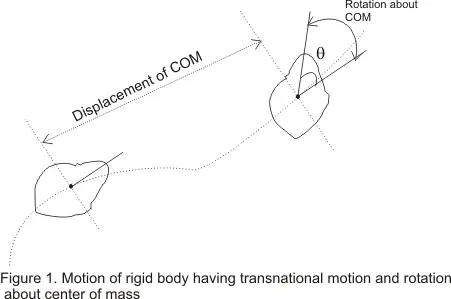
- In this chapter we will concentrate on the simplest kind of rotation that is the rotation of the rigid body about the fixed axis
(2) Angular velocity and angular acceleration
- Consider a rigid body of arbitrary shape rotating about a fixed axis through point O and perpendicular to the plane of the paper as shown below in the figure-1 FIG
- while the body is rotating each and every point in the body moves in a circle with their center lying on the axis of rotation and every point moves through the same angle during a particular interval of time
- Consider the position of a particle say ith particle at point P at a distance ri from point O and at an angle θi which OP makes with some reference line fixed in space say OX as shown below in the figure

- If particle moves an small distance dsi along the arc of the circle in small amount of time dt then
dsi=vidt ----(1)
where vi is the speed of the particle - dθ is the angle subtended by an arc of length dsi on the circumference of a circle of radius ri,so dθ( in radians) would be equal to the length of the arc divided by the radius
i.e.
dθ=dsi/ri =vidt/ri ----(2) - distance dsi would vary from particle to particle but angle dθ swept out in a given time remain same for all the particles i.e. if particle at point P moves through complete circle such that
dθ=2π rad
Then all the other particles of the rigid body moves through the angular displacement dθ=2π - So rate of change of angle w.r.t time i.e. dθ/dt is same for all particles of the rigid body and dθ/dt is known as angular velocity ω of the rigid body so
ω=dθ/dt ----(3) - Putting equation (3) in equation (2) we find
vi=ri(dθ/dt) =riω ---(4)
This shows that velocity of ith particle of the rigid body is related to its radius and the angular velocity of the rigid body - Angular velocity of a rotating rigid body can either be positive or negative. It is positive when the body is rotating in anticlockwise direction and negative when the body id rotating in clockwise direction
- Unit of angular velocity radian per second (rad-s-1) and since radian is dimensionless unit of angle so dimension of angular velocity is [T-1]
- Instead of radians angles are often expressed in degrees. So angular velocity can also be expressed in terms of degree per second and degree per minute
- we know that
2π radians =3600
or π radians/1800=1 And this relation can be used for expressing angular velocity in degree to that of angular velocity in terms of radian - Angular acceleration is the rate of change of angular velocity w.r.t time. Thus for rigid body rotating about a fixed axis

- Unit of angular acceleration is radian /sec2
- Angular acceleration holds not only for that rotating rigid body but also for the each and every particle of that body
- Differentiating equation (4) w.r.t to t we find

where ai=ait=riα is the tangential component of linear acceleration of a point at a distance ri from the axis - Each particle in the rigid body also has the radial linear acceleration component v2/r ,which can also be expressed in terms of an of angular velocity i.e.

and this acceleration aic pointing inwards towards the radial line is also known as centripetal acceleration
(3) Rotation with constant angular acceleration
- when a rigid body rotates with constant acceleration we have

- Thus we have
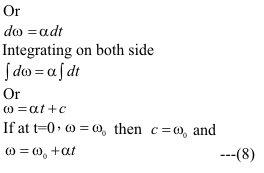
- Again we have angular velocity
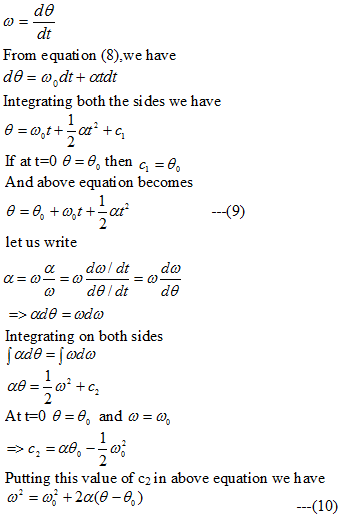
- Equation (8) ,(9) and (10) are the equation of motion with constant angular acceleration
(4) Kinetic energy of Rotation
- From equation(4) we know that magnitude of velocity of the ith particle in a rigid body rotating about a fixed axis is
vi=ri(dθ/dt) =riω where ri is the distance of particle from the axis of rotation and ω is the velocity of the particle - Kinetic energy of the ith particle of mass mi is given by

- The total kinetic energy of the rigid body as a whole would be equal to the sum of KEs of all particles in the body thus

- Since angular velocity ω is same for all the particles in the body so

- The quantity

tell us how the mass of the rotating body is distributed about the axis of rotation is known as rotational inertia or moment of inertia of the rotating body - Moment of inertia of the rigid body can be obtained by imaging the body to be subdivided into large number of particles ,the mass of the each particle is then multiplexed by its squared distance from the axis and then summing over these products for all the particles in the body
- Si unit of moment of inertia is Kgm2
- So rotational kinetic energy of a body can now be written as

- Above expression of rotational kinetic energy KE of a rotating rigid body is analogous to the translational kinetic energy where moment of inertia is analogous to mass m (or inertia) and angular velocity is analogous to velocity v
- Moment of inertia not only depends on the mass but also on how this mass is distributed about the axis of rotation and it must be specified first before calculating moment of inertia of any body
- If the body under consideration is of continuous distribution of matter instead of discrete then moment of inertia is evaluated by means of integration rather then that by summation and this point will be discussed in more detail in our next topic
(5)Calculation of moment of inertia
- We already know that the moment of inertia of a system about axis of rotation is given as

where mi is the mass of the ith particle and ri is its perpendicular distance from the axis of rotation - For a system consisting of collection of discrete particles ,above equation can be used directly for calculating the moment of inertia
- For continuous bodies ,moment of inertia about a given line can be obtained using integration technique
- For this imagine dividing entire volume of the rigid body into small volume elements dV so that all the points in a particular volume element are approximately at same distance from the axis of rotation and le r be this distance
- if dm is the mass of this volume element dV,then moment of inertia may be given by

- Since density ρ of the element is defined as mass per unit volume so ρ=dm/dV hence equation (13) may be written as

- For homogeneous body density ρ is uniform hence ρ can be taken out of the integral sign i.e.

above integration can be carried out easily for bodies having regular shapes as can be seen from examples given below
- Consider a homogeneous and uniform rod of mass M and length L as shown below in the figure
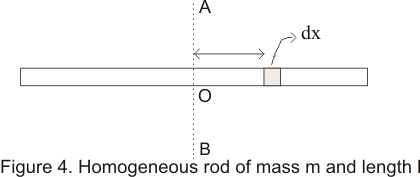
- we have to calculate the moment of inertia of the rod about the bisector AB
- Consider middles point O to be the origin of the rod .Also consider an element of the rod between the distance x and x+dx from the origin. Since the rod is uniform so its density
ρ=M/L
Hence mass of the element dm=(M/L)dx - Perpendicular distance of this element from line AB is x,so that moment of inertia of this element about AB is

- For x=-L/2,the element is at the left end of the rod ,As x changes from -L/2 to +L/2 ,the element covers the whole rod
- Thus the moment of inertia of the entire rod about AB is

- Consider a uniform circular plate of mass M and radius R as shown below in the figure
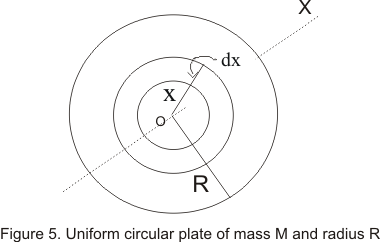
- Let O be the center of the plate and OX is the axis perpendicular to the plane of the paper
- To find the moment of inertia of the plate about the axis OX draw two concentric circles of radii x and x+dx having these centers at O,so that they form a ring
- Area of this ring is equal to its circumference multiplied by its width i.e.
Area of the ring =2πxdx - Mass of the ring would be

- Moment of inertia of this ring about axis OX would be

- Since whole disc can be supposed to be made up of such like concentric rings of radii ranging from O to R ,we can find moment of inertia I of the disc by integrating moment of inertia of the ring for the limits x=0 and x=R
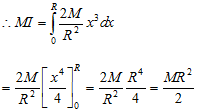
- Consider a sphere of mass M and radius R .Let us divide this sphere into thin discs as shown in the figure
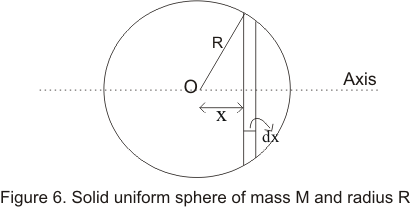
- If r is the distance of the disc then

- Volume of the disc would be

and its mass would be
dm=ρdV - Moment of inertia of this disc would be

Moment of inertia of the whole sphere would be
Factor 2 appears because of symmetry considerations as the right hemisphere has same MI as that of left one - Integration can be carried out easily by expanding (R2-x2)2 .On integrating above equation we find

Now mass of the sphere is
Hence
(6) Theorems of Moment of Inertia
- There are two general theorems which proved themselves to be of great importance on moment of inertia
- These enable us to determine moment of inertia of a body about an axis if moment of inertia of body about some other axis is known
- This theorem is applicable only to the plane laminar bodies
- This theorem states that, the moment of inertia of a plane laminar about an axis perpendicular to its plane is equal to the sum of the moment of inertia of the lamina about two axis mutually perpendicular to each other in its plane and intersecting each other at the point where perpendicular axis passes through it
- Consider plane laminar body of arbitrary shape lying in the x-y plane as shown below in the figure
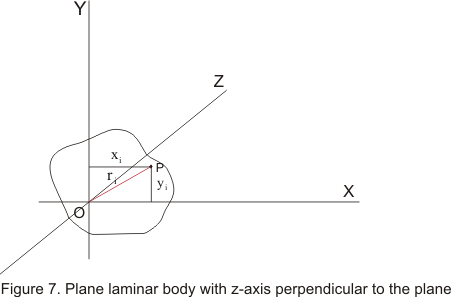
- The moment of inertia about the z-axis equals to the sum of the moments of inertia about the x-axis and y axis
- To prove it consider the moment of inertia about x-axis

where sum is taken over all the element of the mass mi - The moment of inertia about the y axis is

- Moment of inertia about z axis is

where ri is perpendicular distance of particle at point P from the OZ axis - For each element
ri2=xi2 + yi2
- This theorem relates the moment of inertia about an axis through the center of mass of a body about a second parallel axis
- Let Icm be the moment of inertia about an axis through center of mass of the body and I be that about a parallel axis at a distance r from C as shown below in the figure
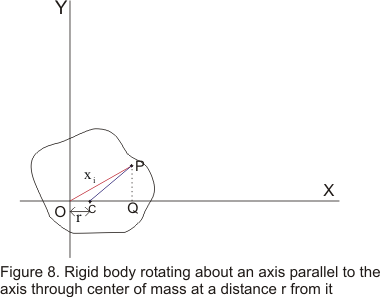
Then according to parallel axis theorem
I=Icm+Mr2 where M is the total mass of the body - Consider a point P of the body of mass mi at a distance xi from O

- From point P drop a perpendicular PQ on to the OC and join PC.So that
OP2=CP2+ OC2+ 2OC.CQ ( From geometry) and miOP2=miCP2+ miOC2+ 2miOC.CQ
- Since the body always balances about an axis passing through center of mass, so algebraic sum of the moment of the weight of individual particles about center of mass must be zero. Here

which is the algebraic sum of such moments about C and therefore eq as g is constant
Thus we have I=Icm + Mr2 ---(17)
(7) Torque
- Consider two forces F1 and F2 having equal magnitude and opposite direction acting on a stick placed on a horizontal table as shown below in the figure
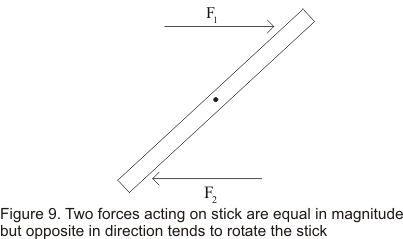
- Here note that line of action of forces F1 and F2 is not same .So they tend to rotate the stick in clockwise direction
- This tendency of the force to rotate an object about some axis is called torque
- Torque is the rotational counterpart of force. torque tends to rotate an body in the same way as force tends to change the state of motion of the body
- Figure below shows a rigid body pivoted at point O so that point O is fixed in space and the body is free to rotate
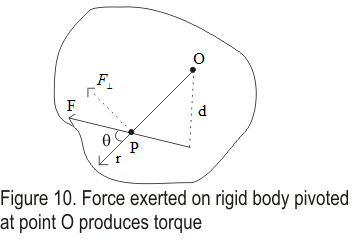
- Let P be the point of application of force. This force acting at point P makes an angle θ with the radius vector r from point O to P
- This force F can be resolved into two components
F⊥=Fsinθ
F||=Fcosθ
as they are perpendicular and parallel to r - Parallel component of force does not produce rotational motion of body around point O as it passes through O
- Effect of perpendicular components producing rotation of rigid body through point O depends on magnitude of the perpendicular force and on its distance r from O
- Mathematically ,torque about point O is defined as product of perpendicular component of force and r i.e.
τ=F⊥r=Fsinθr=F(rinθ)=Fd ---(18)
where d is the perpendicular distance from the pivot point ) to the line of action of force F - Quantity d=rinθ is called moment arm or liner arm of force F .If d=0 the there would be no rotation
- Torque can either be anticlockwise or clockwise depending on the sense of rotation it tends to produce
- Unit of torque is Nm
- Consider the figure given below where a rigid body pivoted at point O is acted upon by the two force F1 and F2
- d1 is the moment arm of force F1 and d2 is the moment arm of force F2
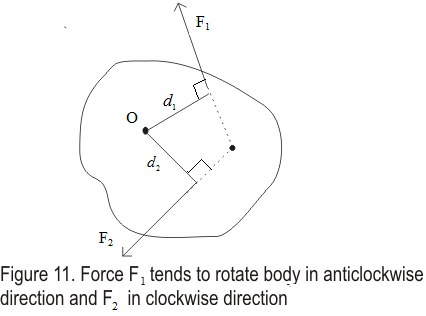
- Force F2 has the tendency to rotate rigid body in clockwise direction and F1 has the to rotate it in anti clockwise direction
- Here we adopt a convention that anticlockwise moments are positive and clockwise moment are negative
- hence moment τ1 of force F1 about the axis through O is
τ1=F1d1
And that of force F2 would be
τ2=-F2d2 - Hence net torque about O is
τtotal= τ1+ τ2
=F1d1-F2d2 - Rotation of the body can be prevented if
τtotal=0
or τ1=-τ2 - We earlier studied that when a body is in equilibrium under the action of several coplanar forces ,the vector sum of these forces must be zero i.e.
ΣFx=0 and ΣFy=0 - we know state our second condition for static equilibrium of rigid bodies that is
" For static equilibrium of rigid body net torque in clockwise direction must be equal to net torque in anticlockwise direction w.r.t some specified axis i.e.
Στ=0
" - Thus for static equilibrium of an rigid body
i) The resultant external force must be zero
ΣF=0
ii) The resultant external torque about any point or axis of rotation must be zero i.e.
Στ=0
(8) work and power in rotational motion
- We know that when we apply force on any object in direction of the displacement of the object ,work is said to be done
- Similarly force applied to the rotational body does work on it and this work done can be expressed in terms of moment of force (torque) and angular displacement θ
- Consider the figure given below where a force F acts on the wheel of radius R pivoted at point O .so that it can rotate through point O
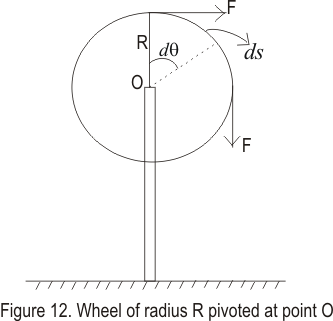
- This force F rotates the wheel through an angle dθ and dθ is small enough so that we can regard force to be constant during corresponding time interval dt
- Workdone by this force is
dW=Fds
but ds=Rdθ
So
dW=FRdθ - Now FR is the torque Τ due to force F.so we have
dW=Τdθ ----(19) - if the torque is constant while angle changes from θ1 to θ2 then
W=Τ(θ2-θ1)=ΤΔθ ---(20)
Thus workdone by the constant torque equals the product of the torque and angular displacement - we know that rate of doing work is the power input of torque so
P=dW/dt=Τ(dθ/dt)=Τω - In vector notation
P=Τ.ω
(9) Torque and angular acceleration
- While discussing and defining torque or moment of force ,we found that necessary condition for a body not to rotate is that resultant torque about any point should be zero
- However this condition is necessary but not sufficient for a rigid body to be static for example in absence of resultant torque a body once set in rotation will continue to rotate with constant angular velocity
- Analogous to translation motion when torque acts on a rigid body rotating about a point with constant angular velocity then angular velocity of the body does not remain constant but changes with angular acceleration α which is proportional to the externally applied torque
- Consider a force Fi acting on the ith particle of mass mi of the rigid body pivoted about an axis through point O as shown below in the figure
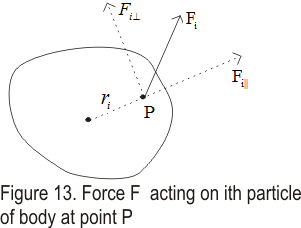
- This force Fi as discussed earlier has two components one parallel to the radius vector ri and one perpendicular to theri
- Component of force parallel to radius vector does not have any effect on the rotation of the body
- Component of force Fi perpendicular does affect the rotation of the body and produces torque about point O through which the body is pivoted which is given by
τi=Fi⊥ri ---(21) - if Fi⊥ is the resultant force acting on the ith particle ,then from Newton’s second law of motion
Fi⊥=miai⊥ = miriα ----(22)
where ai⊥ is the tangential acceleration of the body - From equation (21) and (22)
τi=miri2α
And taking sum over all the particles in the body we have
∑τi=∑(miri2α)=α∑(miri2) ---(23)
as angular acceleration is same for all the particles of the body - we know that
∑(miri2) =I
where I is the moment of inertia of the rigid body .Hence in terms of moment of inertia equation 23 becomes
∑τ=Iα ---(24)
we have denoted resultant torque acting on the body ∑τsub>i as ∑τ - Both the torque and angular acceleration are vector quantities so in vector form
∑τ=Iα ---(25) - Alternatively equation (24) which is rotational analogue of Newton second law of motion ( ∑F=ma) can be written as
∑τ=Iα = I(dω/dt)=d(Iω)/dt ---(26)
which is similar to the equation
F=d(mv/dt=dp/dt
where p is the linear momentum - The quantity Iω is defined as the angular momentum of the system of particles
Angular momentum =Iω
L=Iω - From equation 26 we see that resultant torque acting on a system of particles equal to the rate of change of the angular momentum
∑τ=dL/dt
(10) Angular momentum and torque as vector product
(A) Angular momentum
- In any inertial frame of refrance the moment of linear momentum of a particle is known as angular momentum or, angular momentum of a particle is defined as the moment of its linear momentul.
- In rotational motion angular momentum has the same significance as linear momentum have in the linear motion of a particle.
- Value of angular momentum of angular momentum is equal to the product of linear momentum and p(=mv) and the position vector r of the particle from origin of axis of rotation.
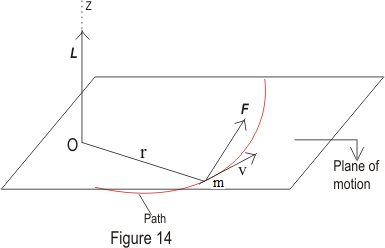
- Angular mmomentum vector is usually represented by L.
- If the linear momentum of any particle is p=mv and its position vector from any constant point be r then abgular momentum of the particle is given by
L = r×p = m(r×v) (1) - Angular momentum is a vector quantity and its direction is perpandicular to the direction of r and p and could be found out by right hand screw rule.
- From equation 1 scalar value or magnitude of angular momentum is given as
|L|=rpsinθ (2)
where V is the angle between r and p. - For a particle moving in a circular path
v=ω×r; (3)
where ω is the angular velocity.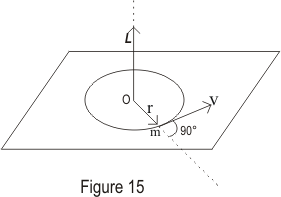
Therefore
L=m[r×(ω×r)] = m{ω(r.r)-r(r.ω)} = mr2ω=Iω; (4)
(r.ω)=0 because in circular motion r and ω are perpandicular to each other. Here I is the moment of inertia of the particle about the given axis also the direction of L and ω is same and this is a axial vector.
writing equation 1 in the component form we get
- Writing angular momentum in component form we get

writing equation 5 again we get
Comparing unit vectors on both the sides we get
- Unit of angular momentum in CGS is gm.cm2/sec and in MKS system it is Kgm.m2/sec or Joule/sec.
- The turning effect of the force about the axis of rotation is called the moment of force or torque..
- In rotational motion torque has same importance as that of force in the linear motion.
- Torque due to a force F is measured as a vector product of force F and position vector r of line of action of force from the axis of rotation.
- We already know that orque is denoted by letter τ.
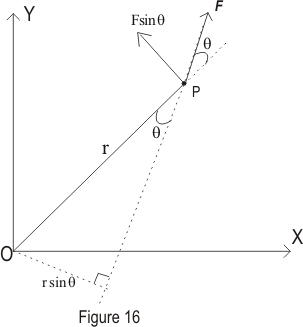
- If F is the force acting on the particle and r is the position vector of particle with respect to constant point then the torque acting on the particle is given by
τ=r×F (8) - FRom equation 8 magnitude or resultant of torque is given by
|τ|=rfsinθ (9)
where θ is the angle between r and F. - From equation 9 if θ=900 this menas r is perpandicular to F then,
- FRom equation 8 magnitude or resultant of torque is given by
|τ|=rF
and if θ=00 this menas r is parallel to F then,
|τ|=0 - Unit of torque is Dyne-cm or Newton-m
(C) Relation between angular momentum and torque
- Differentiating equation 1 w.r.t. t we get
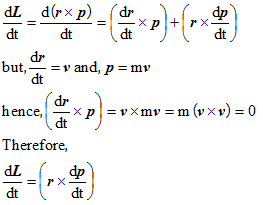
- But from Newton's second law of motion we have
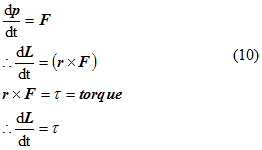
Hence rate of change of angular momentum with time is equal to the torque of the force.
(11)Angular momentum and torque of the system of particles
(A) Angular momentum of system of particles
- Consider a system of particles made up of number of particles, moving independently to each other. Let L1, L2,L3,.............etc. be the angular momentum of different particles of the system w.r.t., to a given point.
- The angulat momentum of the particle system w.r.t. that given point is equal to the vector sum of angular momentum of all the particles of the system.
- If L is the angular momentum of the system of particles or the body as a whole then,

- Torque acting on the system of particles from equation above angular momentem of the system of particles is given as
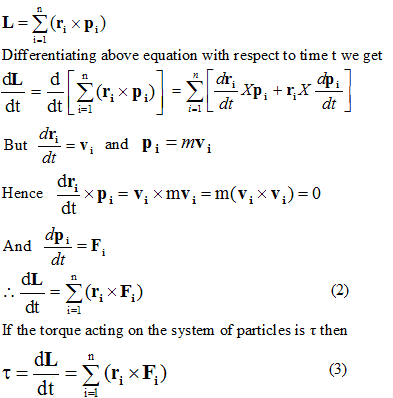
- When particles of the system are in motion then their motion is due to external and interaction due to internal forces so force acting on any particle of the system is given by

Here Fiext is the external force acting on the ith particle and ∑Fij is the sum of the force acting on the particle due to internal interaction of different particles.Putting the value of Fi in the equation we get
- RHS of the equation 2 shows that summantion of the moment of interacting force (internal) .Here internal interaction forces balance each other so torque due to internal forces adds to zero hence
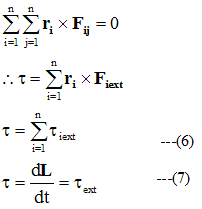
- Above equation proves that total torque acting on a system of particles is equal to the vector sum of the torque acting on the different particles due to external force on the particle and its value is also equal to the rate of change of angular momentum
(12) Angular momentum of the system of particles with respect to the center of mass of the system
- let a system of particles is made up of n number of particles.Let ri be the position vector of the ith particle P with respect to a poiint O and vi be its velocity .let Rcm be the position vector of center of mass C of the system with respect to the origin
- Let ri' and vi' be the position vector and velocity vector of the ith particle with respect to center of mass of the system.
- Angular momentum of the system of particles with respect to origin is given by

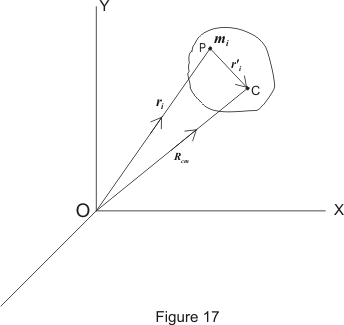
- Angular momentum of the system of particles with respect to center of mass of the system is given by
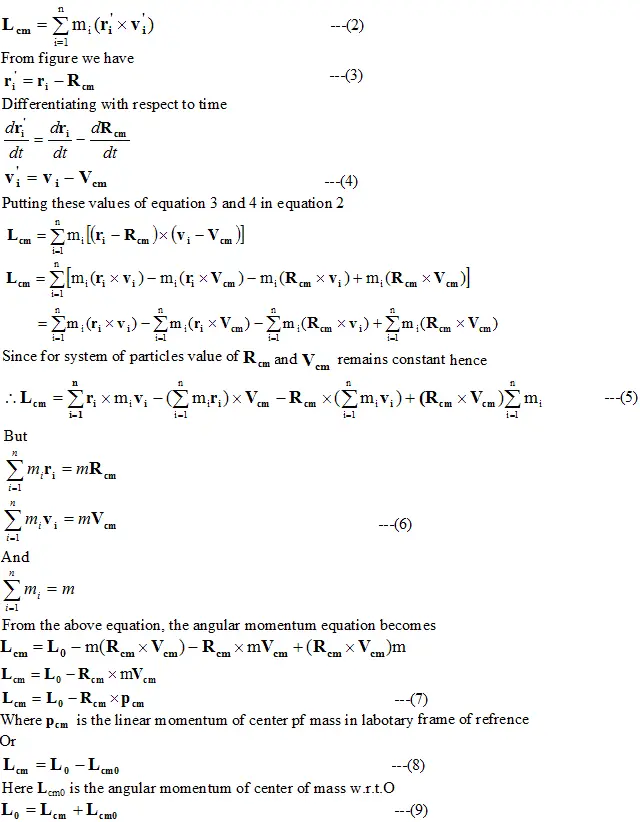
Hence the angular momentum of the system of the particles with respect to point O is equal to the sum of the angular momentum of the center of mass of the particles about O and angular monentum of the system about center of mass
- Torque acting on any particle is given by

If external torque acting on any particle os zero then,
- Hence in absence of external torque the angular momentum of the particle remains constant or conserved.
- Total torque acting on any system is given by

- If total external force acting on any particle system is zero or,

- If total external torque acting on any body is zero , then total angular momentum of the body remains constant or conserved.
(14) Radius of gyration
- Whatever may be the shape of the body it is always possible to find a distance from the axis of rotation at which whole mass of the body can be assumed to be concentrated and even then its moment of inertia about that axis remains unchanged.
- If whole mass of the body is supposed to be concentrated at a distance k from the axis of rotation then
I=Mk2=Σmr2
or ,
k=√(I/M)=√(Σmr2/M)
This quantity k is called radius of gyration of the body about the axis of rotation. - Thus, the radius of gyration of a body, rotating about a given axis of rotation is the radial distance from the axis and when the square of radius of gyration (k) is multiplied by the total mass of the body it gives the moment of inertia of the body about that axis.
(15) Kinetic Energy of rolling bodies (rotation and translation combined)
- Let us now calculate the kinetic energy of a rolling body. For this consider a body with circular symmetry for example cylinder, wheel, disc , sphere etc.
- When such a body rolls on a plane surface , the motion of such a body is a combination of translational motion and rotational motion as shown below in the figure.
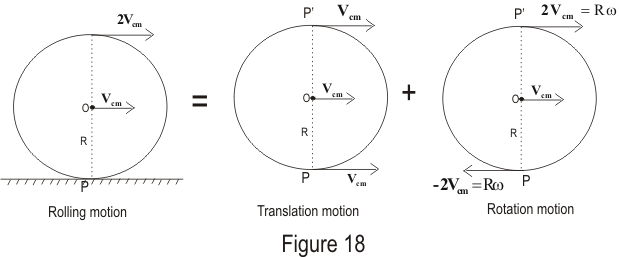
- At any instant the axis normal to the digram through the point of contact P is the axis of rotation. If the speed of the centre of mass relative to an observer fixed on the surface is Vcm then the instantaneous angular speed about an axis through P would be
ω=Vcm/R
where R is the radius of the body. - To explain this consider the figure given below
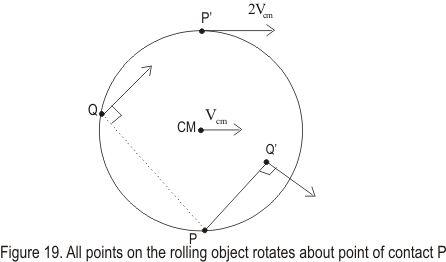
At any instant different particles of the body have different linear speeds. The point P is at rest Vcm=0 instantaneously , the centre of mass has speed Vcm=Rω and the highest point on the circumfrance p' has speed Vcm=2Rω relative to point P. - Now again consider the first figure the top of the cylinder has linear speed Vcm+ Rω=Vcm+Vcm=2Vcm, which is greater than the linear speed of any other point on the cylinder. We thus note that the center of mass moves with linear speed Vcm while the contact point between the surface and rolling objectr has a linear speed of zero.
- Therefore at that instant all particles of the rigid body are moving with the same angular speed ω about the axis through P and the motion of the body is equivalent to pure rotational motion.
- Thus total kinetic energy is
K=½(IPω2)
where IP is the moment of inertia of the rigid body about point P. - From parallel axis theorem
IP=Icm+MR2
where Icm is the moment of inertia of the body of mass M about parallel axis through point O.
Therefore
K=½(Icmω2)+½(MR2ω2)=½(Icmω2)+½(M(Vcm)2)
here the first term represents the rotational kinetic energy of the cylinder about its center of mass, and the second term represents the kinetic energy the cylinder would have if it were just translating through space without rotating. Thus, we can say that the total kinetic energy of a rolling object is the sum of the rotational kinetic energy about the center of mass and the translational kinetic energy of the center of mass. - If k is the radius of gyration of the body about a parallel axis through O then I=Mk2 and total kinetic energy would then be,

Solved examples
Question 1. A mass is whirled in a circular path with constant angular velocity and its angular momentum is L.If the string is now halve keeping the angular velocity same then angular momentum is
a. L
b. L/4
c. L/2
d. 2L
Solution 1
Angular momentum for this is defined as
=mr2ω
First case
L=mr2ω
Second case
Lf=m(r/2)2ω
So Lf=L/4
Question 2.A mass is moving with constant velocity along a line parallel to xaxis away from origin.its angular momentum with respect to origin is
a. is zero
b. remains constant
c. goes on increasing
d. goes on decreasing
Solution 2
L=(mv)Xr
or
L=mvrsinθ
Now rsinθ=perpendicular distance from x axis which is constant
So Angular momentum is constant
Question 3.A cylinder rolls up the incline plane reaches some height and then roll down without slipping through out this section.The direction of the frictional force acting on the cylinder are
a. Up the incline while ascending and down the incline while descending
b.Up the incline while ascending and desending
c. down the incline while ascending and up the incline while descending
d.down the incline while ascending and desending
Solution 3:
Imagine the cylinder to be moving on a frictionless surface.In both the cases the acceleration of the CM of the cylinder is gsinθ.This is also the acceleration of the point of contact
of the cylinder and the inclined plane..Also no torque (about the center of the cylinder) is acting on the cylinder since we assumed the surface to be a frictionless and the forces
acting on the cylinder is mg and N which passes through the center of the cylinder.Therefore the net movement of the point of contact in both the cases is in downward direction
Therefore frictional force will act in upward direction in both the cases
Question 4.A uniform sold sphere rolls on the horizontal surface at 20 m/s.it then rolls up the incline of 30.If friction losses are negligible what will be the value of h where sphere stops on the incline
a. 28.6 m
b 30 m
c. 28 m
d. none of these
Solution 4
Let h be the height
The rotational and translational KE of the ball at the bottom will be changed to Gravitational energy when the sphere stops .
We therefore writes
(1/2)Mv2+(1/2)Iω2=Mgh
For a solid sphere I=(2/5)Mr2 and also ω=v/r
So (1/2)Mv2+ (1/2)(2/5)Mr2(v/r)2=Mgh
or
v2/2 +v2/5=gh
or h=28.6 m
Question 5. A cylinder of Mass M and radius R rolls down a incline plane of inclination θ.Find the linear accleration of the cylinder
a. (2/3)gsinθ
b.(2/3)gcosθ
c gsinθ
d none of these
Solution 5
Net force on the cylinder
Fnet=mgsinθ -f
or ma=mgsinθ -f
Where f is the frictional force
Now τ=fXR=Iα
Now in case of pure rolling we know that
a=αR => α=a/R
So f=Ia/R2
From 1 and 2
a=mgsinθ /[m+(I/R2)]
Now I=mR2/2
So a=(2/3)gsinθ
Question 6 An ice skater spins with arms outstretch at 1.9 rev/s.Her moment of inertia at this time is 1.33 kgm2.She pulls her arms to increase her rate of spin.Her moment of inertia after she pulls her arm is .48kgm2.What is her new rate of spinning
a. 5.26 rev/s
b. 5.2 rev/s
c 4.7 rev/s
d. none of thes
Solution 6
Law of conservation of angular momentum
I1ω1=I2ω2
or
1.33(1.9)=.48ω2
or
ω2=5.26 rev/s
Question 7. Moment of inertia of a uniform rod of lenght L and mass M about an axis passing through L/4 from one end and perpendicular to its lenght
a. 7ML2/36
b.7ML2/48
c. 11ML2/48
d.ML2/12
Solution 7
Using parallel axis theorem
I=Icm+Mx2 where x is the distance of the axis of the rotation from the CM of the rod
So x=L/2-L/4=L/4 Also Icm=ML2 /12
So I=ML2 /12+ML2 /16=7ML2 /48
Question 8. A wheel starts from rest and spins with a constant angular acceleration. As time goes on the
acceleration vector for a point on the rim:
a. increases in magnitude but retains the same angle with the tangent to the rim
b.increases in magnitude and becomes more nearly radial
c. increases in magnitude and becomes more nearly tangent to the rim
d. decreases in magnitude and becomes more nearly radial
Solution 8
Tangential acceleration=radius* angular acceleration
Since angular acceleration is constant ...Tangential acceleration is constant
Radial acceleration=r* (angular velocity)2
Since angular velocity increase with time...Radial acceleration increase with time
So resulttant acceleration increase with time and becomes more radial as time passes
Question 9.
Two wheels are identical but wheel B is spinning with twice the angular speed of wheel A. The ratio of the
magnitude of the &radical acceleration of a point on the rim of B to the magnitude of the radial acceleration of
a point on the rim of A is:
a. 4
b . 2
c 1/2
d 1/4
Solution 9.
Radial acceleration=r* (ω)2
For wheel A
Radial acceleration of A =r* (ω)2
For wheel B
Radial acceleration of B=r* (2ω)2=4r* (ω)2
So Radial acceleration of B/Radial acceleration of A=4:1
Question 10. For a wheel spinning with constant angular acceleration on an axis through its center, the ratio of
the speed of a point on the rim to the speed of a point halfway between the center and the rim is:
a 2
b 1/2
c 4
d 1/4
Solution 10
At rim
v=rω
At point between the center and rim
v=(r/2)ω
Ratio =2
Question 11. A wheel initially has an angular velocity of 18 rad/s. It has a constant angular acceleration of 2.0 rad/s2 and is
slowing at first. What time elapses before its angular velocity is18 rad/s in the direction opposite to its initial
angular velocity?
a 3 sec
b 6 sec
c 18 sec
d none of these
Solution 11
ω0=18
ω=-18
anugular acceleration(α)=-2
Now
ω=ω0+αt
or t=18
Question 12. One solid sphere X and another hollow sphere Y are of same mass and same outer radii. Their moment of inertia about their diameters are respectively Ix and Iy such that
(A) Ix= Iy
(B) Ix > Iy
(C) Ix < Iy
(D) Ix/Iy=Dx/Dy
Where Dx and Dy are their densities.

No comments:
Post a Comment